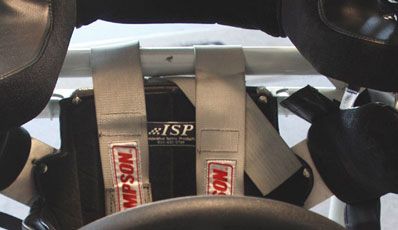
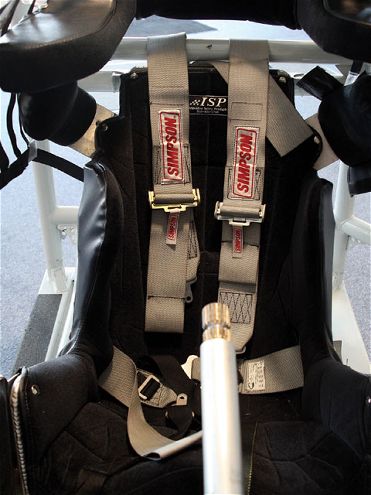 No matter the quality or cost of your racing seat and harness system, it is only as effective as your methods for mounting everything inside your race car.
No matter the quality or cost of your racing seat and harness system, it is only as effective as your methods for mounting everything inside your race car.
Thanks to NASCAR's big push to improve driver safety in the past few years, the trickle-down effect has produced greatly improved seat and belt designs that are affordable for the Saturday night racer. For once, something besides the ever-increasing costs of racing is being passed down from the big leagues to us regular racers.
However, the quality of your harness and racing seat means little if they aren't properly installed in your race car. The idea of a seat and harness system is to hold the body with very little movement in the case of an accident. Even with the smallest race car drivers, the weight of the human body can produce tremendous inertial forces when it is allowed to move even an inch or two during a crash. For example, a 200-pound man in an accident that results in a 70g hit, which isn't unusual in racing, produces 15,000 pounds of force. To help your safety systems hold your body in place during a potentially violent crash, your seat and belts must be securely mounted in the race car and the mounts have to be in the right place. And don't make the mistake of believing you have to be on a big NASCAR-style superspeedway to require top-of-the-line safety equipment. It is actually the smaller tracks that produce the biggest hits because the turns are sharper. Because of this, when you get out of shape, the wall will come up on you more quickly. You are a lot more likely to take a hard hit into the wall at a bullring than at Daytona, where the turns are gradual.
"The most important thing when it comes to mounting your seatbelt brackets is to give your belts the opportunity to work the way they are designed," says racing seat builder Kris VanGilder, owner of Innovative Safety Products (ISP). "That means the belts should have the proper angles across your body, and they should also be in a straight line across your body."
ISP is one of the top racing seat manufacturers, providing comprehensive seating systems to race teams at every level. ISP arguably has as much sled testing experience as any private safety products manufacturer. But you may be surprised to hear that VanGilder says the greatest portion of any workday for him is spent educating racers and crew chiefs-everyone from the Cup level to the Late Model ranks-on how to properly fit and install a comprehensive restraint system. "It is that important," he says. "The best seat in the world won't do any good if the overall system isn't sound."
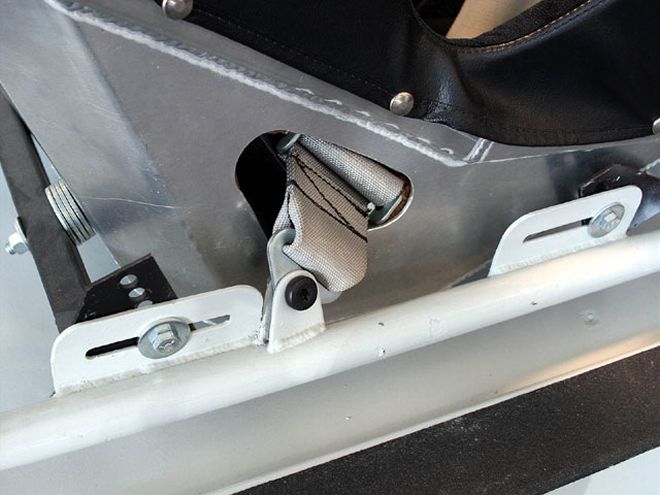 Notice how the mount for this lap belt allows the bracket that the belt threads through to swivel. This allows the belt to be loaded evenly across the bracket in the event of an accident and greatly reduces the chances of the belt "dumping" or tearing because of all the pressure building up along one edge.
Notice how the mount for this lap belt allows the bracket that the belt threads through to swivel. This allows the belt to be loaded evenly across the bracket in the event of an accident and greatly reduces the chances of the belt "dumping" or tearing because of all the pressure building up along one edge.
MOUNTING TO THE CAR
The primary point of emphasis when mounting your seatbelt and racing seat inside your car is that the mounts should never connect directly to the car's frame or sheetmetal. Both the seatbelt and seat should mount to a "seat hoop" that is connected to the rollcage. This way, if the driver takes a side impact that is strong enough to move the 'cage, the seat and harness will move with it. The idea is to protect the driver from being injured by his or her own rollcage.
VanGilder says that the seatbelt mounts should also allow the belt to swivel. This keeps the belt in a straight line between the mounting point and the buckle. In the event of an accident, the force of the driver's body against the belt is distributed evenly. If the seatbelt bracket cannot swivel, there is the potential for the belt to be loaded unevenly, which greatly increases the chances for equipment failure. This phenomenon is called "web dumping." It works much the same way as the old trick where it is impossible to tear a phone book in half but relatively easy if you open it and rip it along the spine. Finally, make sure to use at least a 31/48-inch or larger bolt for all your fasteners.
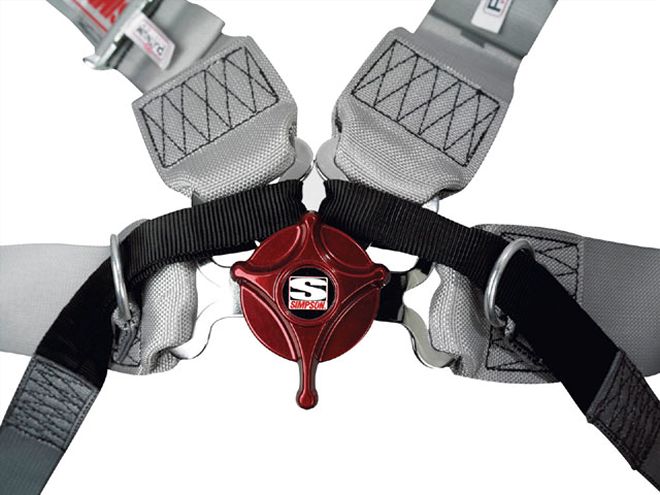 Switching from a traditional five-point belt system to a six-point system with two leg straps does not complicate the buckling system. The leg straps thread onto the shoulder belt buckles before they are locked into position. If a fast exit is necessary, simply releasing the buckle frees all six belts.
Switching from a traditional five-point belt system to a six-point system with two leg straps does not complicate the buckling system. The leg straps thread onto the shoulder belt buckles before they are locked into position. If a fast exit is necessary, simply releasing the buckle frees all six belts.
LAP BELTS
VanGilder says the key component of the harness system for protecting the driver-even against head and neck injuries-is the hip (or lap) belt. This is because when you are in a seated position, the pelvis is the center of mass in your body. It is also capable of handling the greatest amount of pressure without injury. VanGilder says that by properly restraining the hips and pelvis, it is much easier to maintain control of the rest of the body in an accident.
"When your pelvis is locked in place, your body produces less momentum and it is easier to control your head," he explains. "Again, the belt should run straight across your hips without any curves or bunching up. Where you've mounted your lap belts to the seat hoop is also important. Once the belts exit the seat, they should come just about straight down. Ideally, you want the lap belts to mount at the same width as your hips. Consider how you would tie down a box in the center of the bed of your pickup truck. If you could, you would anchor the straps as close to the sides of the box as possible because if the straps were anchored way out wide, the box can slide around underneath the strap.
"Also, you want the lap belt anchors behind the tail bone laterally. This helps pull you down into the seat. Combine that with a slight angle to the bottom of the seat, and this really helps lock you in place. Now, in the event of a frontal hit, you would have to rise up before you could come out of your seat."
CROTCH/LEG STRAPS
The crotch strap is also referred to as the antisubmarine belt. Its purpose is to keep you from sliding underneath your lap belt, but it is also useful to help make sure your lap belt stays properly positioned. Often, male drivers are uncomfortable if the crotch strap is too tight, but it must be at the proper length so that the lap belt cannot ride up over the hips and onto the stomach.
"You've got to make sure the lap belt stays on your hips because your hips can take over 4,000 pounds of force without you getting injured," VanGilder explains. "But just at 800 pounds of load across your stomach, you are going to get hurt. That's a big difference in terms of what we can do to protect you on the racetrack. Right now, I have systems that can take a 72g hit and still properly protect the body so that you should be able to walk away from the car. But it's all about seatbelts and angles. If the angles and the position of the belts aren't right, then nothing will protect you."
You may also want to consider switching out the standard five-point harness system with a crotch strap to a six-point system that ditches the single crotch strap in favor of two leg straps. The leg straps wrap across the inside and top of the legs before securing at the buckle. They are an improvement over the crotch-strap system because they assist the lap belt in anchoring the pelvis. Also, male racers are often more comfortable with the two leg straps and are willing to cinch them down tighter. VanGilder says that the six-point belt systems are quickly gaining popularity because they are both safer and more comfortable, and he estimates that 90 percent of the seats he is currently selling are configured for the six-point system. The leg belts (and sometimes the crotch strap) are the only portions of the harness that do not attach directly to the rollcage. Instead, most seat builders mount these belts to a steel plate that is located underneath the aluminum racing seat.
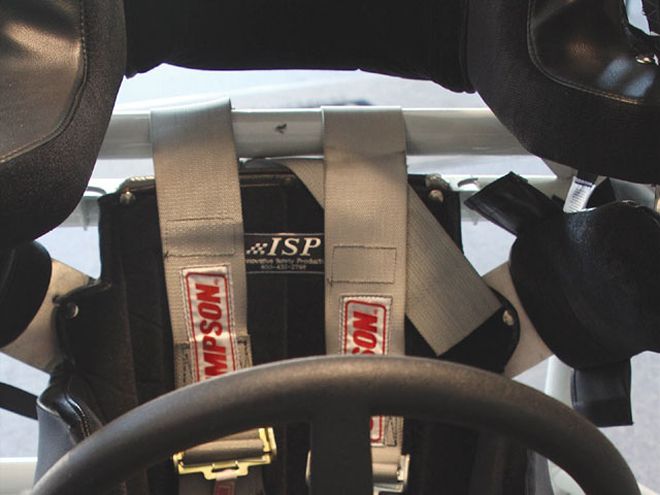 The shoulder straps should be mounted to the rollcage so that the portion of the belt that runs between the mount and the top of the driver's shoulders is 90 degrees to the line of his spine.
The shoulder straps should be mounted to the rollcage so that the portion of the belt that runs between the mount and the top of the driver's shoulders is 90 degrees to the line of his spine.
SHOULDER STRAPS
The purpose of the shoulder straps is to anchor the driver's torso against the seat. Although brevity is necessary with all the belts, you especially want to keep the shoulder straps as short as possible because they are the longest pieces of the system. Any safety harness will allow a certain percentage of stretch, so the longer the belt, the more overall stretch it will allow. To minimize shoulder-belt length, the belts should mount to a rollcage bar almost directly behind the driver's seat and approximately level with his or her shoulder blades (or slightly higher).
The height of the shoulder strap mounts is critical because if they are too low they can actually compress the driver's spine in a collision. But if the mounting position is too high, the driver will be allowed to slide up in his or her seat if the car is overturned.
VanGilder says that the location of the shoulder strap mounts depends on the position of the driver. The mounts should be at a 90-degree angle to the line of the driver's spine. That means if the seat is more reclined, the mounts should be lower. But if the seat has the driver sitting up straight, the mounts should be higher. No modifications are necessary depending on whether the driver wears a head-and-neck restraint such as a HANS Device. Remember that these guidelines for properly mounting your seat and belts could be the difference between walking away from a crash and being carried out on a stretcher. But there is no substitute for talking with the belt and seat manufacturer. The manufacturer you choose will offer resources to help you properly mount your seat and belts.
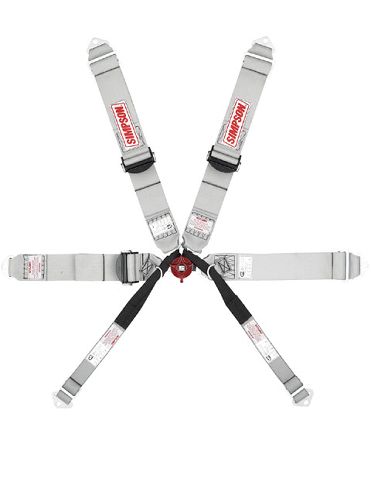 The newest innovation in racing harnesses is a polyester-blend belt-such as this Platinum series harness from Simpson-that is both stronger and more wear resistant than traditional belts constructed from nylon.
The newest innovation in racing harnesses is a polyester-blend belt-such as this Platinum series harness from Simpson-that is both stronger and more wear resistant than traditional belts constructed from nylon.
BETTER THAN A LEISURE SUIT
It turns out that polyester has a useful purpose after all. Forget that George Jefferson leisure suit hanging in the back of your closet. Polyester is making a comeback in racing. During our discussions with ISP's Kris VanGilder, he mentioned sled testing with upgraded polyester belts versus the standard nylon belts. It turns out that as a material, polyester has properties that are very advantageous in a racing harness system. Simpson Racing Products is now producing new polyester belts in its Platinum line (They are easily recognized because they are silver).
Versus nylon restraints, Simpson says its polyester-blend belts are 20 percent stronger and stretch approximately 9 percent less. They are also more resistant to chemicals, moisture, and abrasion, meaning they are less likely to weaken over time. Moisture resistance should be a big concern for racers because it is easy to wet a belt with your own sweat during a race on a hot summer night, and a nylon belt loses approximately 12 percent of its strength when wet. No matter which brand you prefer, if you haven't already, you may want to consider upgrading to polyester when purchasing your next set of belts.
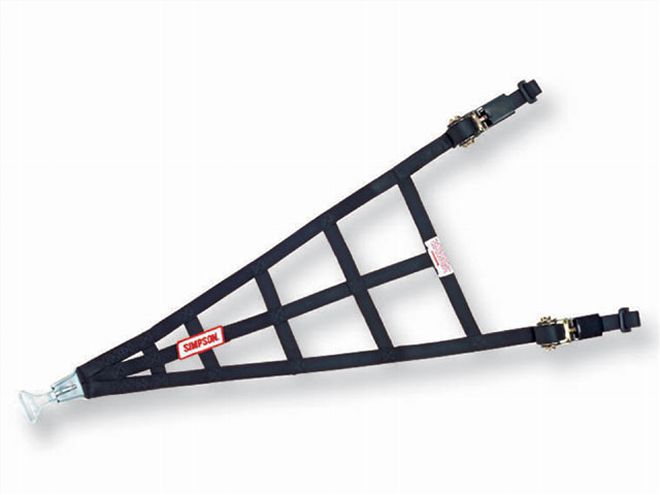 A head net isn't a replacement for a head support that is a part of your racing seat, but it can help greatly improve the effectiveness of that head support.
A head net isn't a replacement for a head support that is a part of your racing seat, but it can help greatly improve the effectiveness of that head support.
HEAD NETS
Another relatively new development is head support nets, or "Sprint Car nets" as many stock car racers call them. Simpson Racing Products says the nets, which are positioned just to the outside of the driver's head supports, help contain the driver's head during a crash and make sure any movement is within a safe zone. In some extreme examples, a driver's head can get caught on the wrong side of the head support, which can be quite dangerous. The large area of the head net keeps that from happening without obstructing the driver's view outside the cockpit too badly.